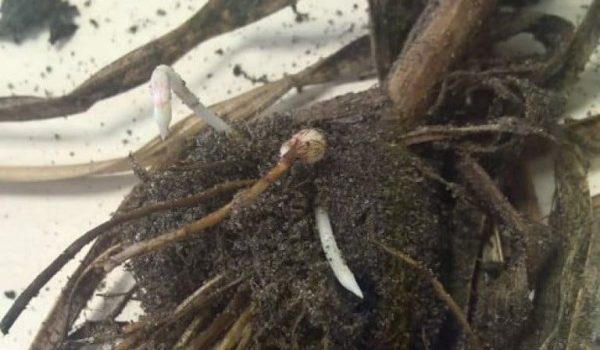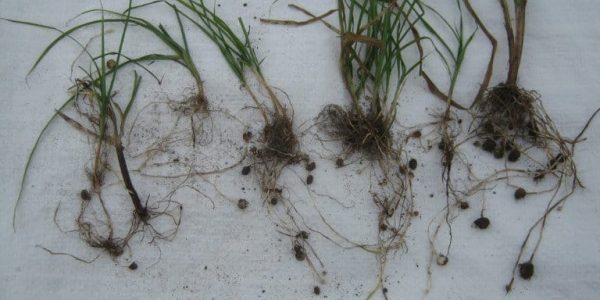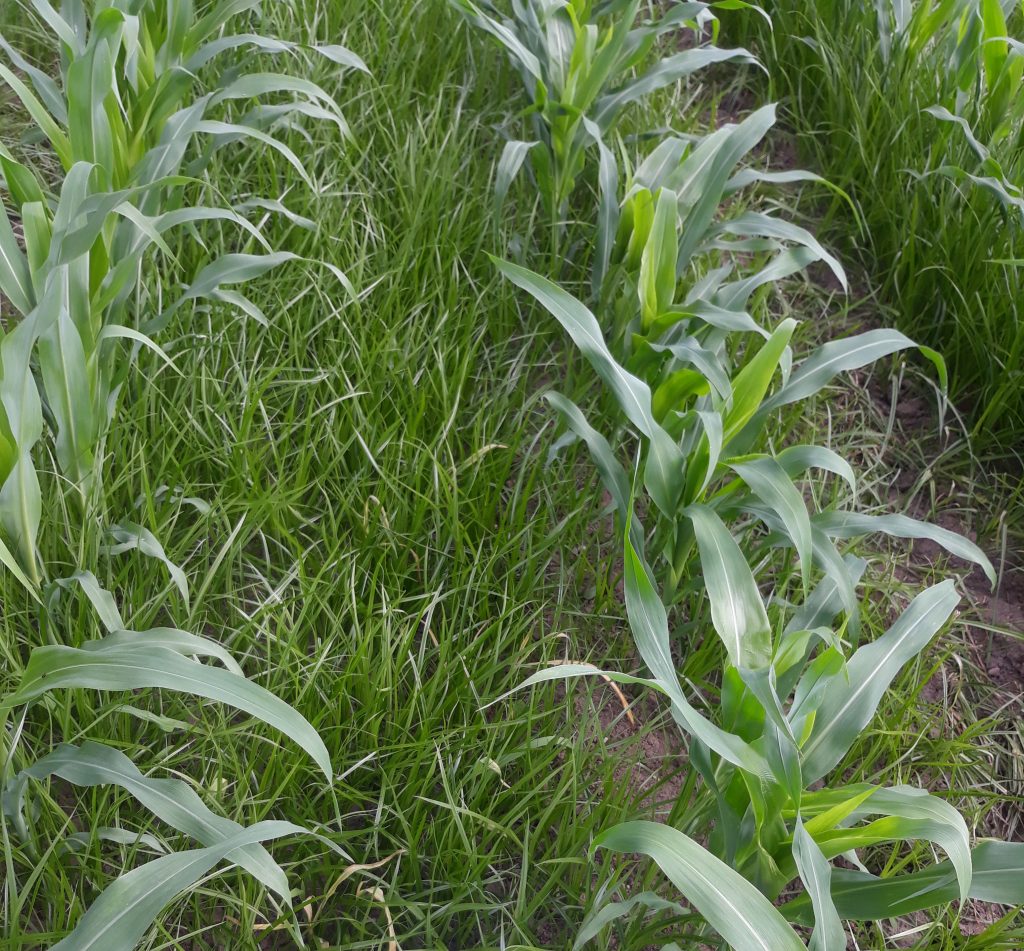Remediation of tuberous cyperus
When dealing with tuber cyperus, there are a number of specific concerns. These mainly focus on avoiding propagation and spread, as control and suppression are only possible with herbicides in a limited number of crops.
Stubborn weeds
Tubercyperus is a very persistent, grass-like weed belonging to the cypergrass family (rushes and sedges). Management, in this case control, is not evident because this weed possesses underground nodules that can survive for years. These nodules can proliferate very rapidly and are therefore the main form of spread. Seed formation can also sometimes be of some significance.
Grassy weeds
The tubers sprout from May, especially in warm and loose soil. The plant has pink feet and laterally growing roots with typical underground shoots. The leaves of the tubercyperus plant grow from the base of the tuber. They are yellow-green in colour. During flowering, stiff triangular stems emerge from the tuber, producing yellow-brown inflorescences from late July to October. The underground tubers (a few mm to a few cm) are white at first, later maroon and eventually almost black. They taste hazelnut-like and are a delicacy in certain southern countries. The above-ground parts die in winter and the tubers are hardy and certain ones germinate for up to 10 years.


Tuberous cypress plant with tubers
The spread of tuber cyperus is mainly through soil particles contaminated with nodules, and this through machinery or supply of contaminated soil.
The plant grows from a mother tuber (or basal tuber) with the formation of offshoots and shoots. Quite soon after emergence, the plant begins to produce new daughter tubers.
Do not underestimate the consequences
Today, it is estimated that about 5 to 10% of plots or some 15,000 to 30,000 ha are infected with tuber cyperus. These infected plots are obviously a real source from where introduction into your plots is possible. This happens mainly through infected soil (particles) left on own machinery or through contract work, also through tare soil returning ....
In the checklist with IPM guidelines include measures to prevent the spread of tuber cyperus. Every grower should take a moment to ask himself whether he is taking sufficient measures to prevent the introduction of this persistent weed. Because once present on the farm, it can have a major impact on the cropping schedule. Tuber cyperus can only be controlled chemically in a very limited number of crops (initially in maize and winter cereals). From an IPM perspective, the presence of tuber cyperus means a ban on growing root, tuber and bulb crops on infected plots.
Since 2023, this ban on contaminated plots has also been included in the conditionality of the CAP. A square metre with more than ten shoots of tuberous cyperus, or with a coverage of more than 50%, is considered an infected square metre. If the number of contaminated square metres exceeds 10, the entire plot is considered to be an infected plot. This plot is subject to the cultivation ban on root, tuber and bulb crops and this conditionality applies. Failure to comply with the cultivation ban will result in a sanction.
Arm yourself with a spade
Carefully check the result of control in maize at the end of June, and make sure this grassy weed does not remain. Also check other crops for any presence. Walk through your field with a spade and dig up the weeds at uncertainty to see if there are runners and tubers present. Contact us if in doubt!
Distribution
The first reports of this weed in West Flanders date back to the early 1980s. It was a quarantine organism with reporting obligations to the FASFC until 2016. This status has since been lifted, but measures still apply within the IPM regulations (point 1.7.1 tem 1.7.5. in the specifications) and the cultivation ban on root, bulb and tuber crops has been included since 2023 as conditionality in the new CAP. It is unclear how many ha are infected in Flanders. Some sources talk about 15,000 ha, but there may be many more.
Cultivation restriction and control obligation
Measures within IPM focus mainly on avoiding further propagation and spread.
All of the following measures should be applied to plots where tuber cyperus has been identified:
- edit plot last
- cleaning machines when leaving the field
- prohibited land disposal
- Apply mechanical or chemical control repeatedly to prevent infestation from spreading from the year of establishment
- the farmer informs any contractor of the presence of tuber cyperus so that they can take the necessary precautions when leaving the field.
Infected plots, i.e. plots with more than 10 m² of infestation, are forbidden to grow root, tuber and bulb crops. If an infestation nevertheless occurs in these crops, harvesting is prohibited.
In the case of cultivated leases, landlord and tenant must enter into an agreement stating that the field is free of tuber cyperus.
Ten basic principles for successful tuber cyperus control
These tips were partly obtained with research within the LA project "Integrated approach to tuber cyperus"
Harvesters of bulbous, root and tuberous crops move large amounts of soil. After harvesting an infected plot, tubers are most likely to be in or attached to the harvester. When you then use the machine on the next field, contamination may occur along the travel path. By far the majority of infections happen this way.
Tillage machinery can give rise to tuber creep, both within and between plots. In an experiment, the risk of dragging was estimated for three tillage machines: a plough, a cultivator and a rotary harrow. The experiment was conducted at dry soil conditions over a length of 40 metres. Especially with the rotary harrow, the risk of creep was found to be high: within the experiment, the tubers moved up to a distance of 40 metres, the maximum distance within the experiment. In principle, the tubers could be spread much further into the field. With the plough and cultivator, the maximum creep was only 2.5 and 4 metres, respectively.
After tillage, a large amount of soil (up to 40 kg) also stuck to the rotor harrow, increasing the risk of inter-field creep. The following points of attention are therefore indispensable to prevent spreading between plots:
- Work infected plots last and clean machines thoroughly after using them on an infected plot.
- To prevent spread within the field, preferably do not work the infected area, especially in the case of an early infestation or a small well-defined hot spot. Or use machines that stir the soil less intensively.
Although most infections occur via tubers, spread via seed is also a possibility. The closer the plant is to the roadside, the more likely it is to produce germinative seeds due to less control and higher light availability. Before the plant produces germinable seeds, fertilisation must first occur. If different genotypes are close together, cross-pollination can occur. This will result in a new genotype, which may be even more difficult to control.
Seeds germinate more easily on sandy soil than on loamy and clay soils. Fortunately, germinating seeds - in contrast to shoots from germinating tubers - can be controlled well using the classic pre-emergence schemes (e.g. in maize cultivation) based on the active substances dimethenamide-P (Frontier Elite, Arundo ...) and S-metolachlor (Dual Gold, Codal ...). A decent effect can also be expected from pethoxamide (including Successor). One-off post-emergence treatments based on soil and foliar herbicides are less robust.
There is a large variation among several tubercyperus clones in Flanders. Most clones produce a large number of rather small daughter tubers. But, in the Kempen (Herselt region) and West Flanders (Meulebeke region) clones have been found to produce larger daughter tubers, albeit in a smaller number. Most Flemish clones are capable of producing inflorescences (and thus seeds), although a number of clones have been found, especially in Limburg, where this is not the case.
Similarly, when looking at susceptibility to foliar herbicides, we see large differences between clones (see below). Differences in herbicide sensitivity between tuber cyperus populations very often explain reported differences in control efficacy between infested plots. This variability in susceptibility highlights (1) the importance of proper timing of foliar herbicides - apply treatments at the most susceptible foliar stage and under optimal weather conditions for foliar uptake of herbicides and (2) the implementation of robust, integrated control systems where individual methods complement and reinforce each other. Ultimately, no single method by itself is sufficient.
Mechanical control is an interesting option especially in dry years as tuber cyperus is quite susceptible to drought and exhaustion. This control aims to deplete the tubers by cutting the plant with knives shortly after emergence. This should be done in good time, before the plant has a chance to produce new daughter tubers.
In 2022, mechanical control was applied for a season on heavily infested fallow land on some field plots. Operations were carried out with the emerald, vibratory tine, disc harrow, hoe ... When applied correctly, the stock of live tubers in the tiller could be reduced by 80%. It is crucial to repeat soil preparation before the oldest tuber cypress plant possesses four true leaves and certainly before tuber formation. To promote nitrate leaching and structure restoration, it is best to end the black fallow with the installation of a fast and well-covered N catch crop or winter cereal. The field plots lay fallow throughout the year, possibly preceded by an early, short crop (e.g. cauliflower or spinach) with harvest in May.
Of course, mechanical control can also offer opportunities in other situations, such as between two short-term vegetable crops or on a cereal stubble. The advantage of short-term crops is that tuber cyperus, if properly controlled, does not reach tuber formation during this crop. By a succession of short crop cycles, you also create a sequence of mechanical soil tillage operations with adverse effects on tuber cyperus development.
Moreover, you have to make sure that you do not spread the tubers yourself with the machines. Small areas of infection are best tackled with a hoe or even better with a spade. However, where mechanical control fails, the tuber cyperus problem is mainly spread.
A well-timed on tubercyperus targeted chemical control remains an important cornerstone in tuber cyperus control. Only a limited number of herbicides are sufficiently effective against this weed to achieve satisfactory results. We list them for you.
In the forefront are the herbicides from the chloroacetamides group. These include dimethenamide-P (including Frontier Elite), metolachlor-S (including Dual Gold) and metazachlor (including Butisan S). Perhaps also pethoxamid (including Successor 600) good soil performance. Sufficient soil moisture is essential for good performance. They are recognised in maize and some also in certain vegetable crops.
Especially in the maize cultivation chemical control options are available. The best results are obtained by uniform and deep (minimum 15 cm) incorporation of S-metalochlor (1.5 l/ha Dual Gold or analogue, not on sandy soil) before sowing or an application of dimethenamide-P (1.4 l/ha Frontier Elite or analogue) immediately after sowing, followed by a double post-emergence application of the active ingredients mesotrion (0.75 l/ha Callisto or analogue) and pyridate (0.83 l/ha Onyx or analogue). Such a scheme can reduce the tuber stock in the soil to 89%. Anyway, in maize, the result depends heavily on the initial infestation pressure and the ability to hit the weeds at the bottom of the maize.
The first post-emergence application can be integrated into general weed control (3-4 leaf stage maize). The second application is very successful when applied as an under-leaf spray (10-11 leaf stage maize). Here, adding a oil (e.g. 1 l/ha Tipo) and the use of a high spray volume (minimum 400 l/ha) adds value. The combination of the active substances mesotrione and pyridate, applied at high RH and on young tuber cyperus plants (3-5 leaf stage), is capable of killing off the parent tuber (control up to 90%).
However, the control does not stop at the completion of chemical control when the foliage closes. The crop must supplement tubercyperus control at that point. After all, tubercyperus is very sensitive to shade. It is therefore very important that the crop forms a uniform and well-closed foliage after completion of the spray schedule to minimise the chances of new tuber formation in July and August. In a poorly closed, irregular crop, tuber cyperus will still manifest itself despite successful chemical control before the 11-leaf stage of maize.
In the vegetable chemical control methods are limited. Bentazon, recognised in bean, pea and grass seed crops, among others, solo has limited activity. In some cabbage crops, some action can be expected from the active ingredients pyridate and S-metolachlor/dimethenamide-P. However, the dose of pyridate in many vegetables is usually too low to be sufficiently effective.
Pot trials showed good effectiveness on young tubercyperus plants of the herbicide sulfosulfuron recognised in certain cereals. However, this herbicide is not legally recognised for use against tuber cyperus.
In some crops, there is also a possibility to hoe between rows, but control in the crop row itself remains a major problem. However, short-term vegetable crops remain interesting, since there is a possibility to control tuber cyperus between crops with soil tillage or an alternative (e.g. electrocution).
In addition, uniform and heavy covering cereals, rye and (winter) barley in particular, are well able to strongly suppress tuber cyperus, except near wheel tracks. Early harvested cereals also offer the possibility of introducing an interim fallow period (warm, dry summer months) in the stubble during which tuber cyperus can be intensively controlled by mechanical or electrophysical methods.
Only with an integrated approach sustained over years can the tuber stock decline steadily over time with reductions of up to 90% over three years. Loosening the reins (too early) once can completely undo the efforts of previous years.
Glyphosate generally has a decent effect on shoots and mother tubers of tuber cyperus, but the control result is highly variable (between 50 and 100%).
The following conditions must be met for the highest possible control:
- It is best to treat at the 5-6 leaf stage as that is when tuber cyperus is most susceptible;
- From August, it is best to treat a little earlier (4-5 leaf stage), as the shorter days will cause the plant to switch to tuber formation earlier;
- Never apply glyphosate on tuber-forming plants as glyphosate does not eliminate new daughter tubers and the approved dose is then insufficient;
- There are large differences in sensitivity to glyphosate between tuberous cyperus clones. Therefore, always choose a topical application at the legally highest possible dose. At the current maximum field dose of 1440 g of glyphosate per ha, glyphosate has insufficient activity against certain clones (34% of clones).
- Good efficacy depends on good foliar uptake and high systemic transport. Therefore, always spray glyphosate at a low spray volume (200-250 l/ha), at high relative humidity and sufficient soil moisture. No effect is to be expected on plants in drought stress.
If the listed conditions are not met, do not apply glyphosate, otherwise there is a chance that uncontested plants will produce more daughter tubers than untreated plants.
There is also plenty of research in the LA pathway into alternative control techniques such as electrocution and hood steaming. Field trials showed that electrocution manages to thermally disable the shoots of tubercyperus. The following conditions must be met for this to happen:
- Treatment is best carried out at a low driving speed (1.1 km/h) and on well-growing plants in the 5-leaf stage. Drought stress - a combination of high air temperature and low soil moisture - can greatly reduce activity (up to 31%);
- Treatments must be repeated several times (up to four times per season) to deplete the mother tubers and control new sprouts. Indeed, the mother tubers are never eliminated through a single treatment An important advantage over soil tillage is that this technique does not drag tubers and can also be worked under wet soil conditions.
At hood steamers (steam application under a hood), a single treatment can lead to 100% control of tubers down to a depth of 25 cm. Although this requires rather long steam durations (20-32 minutes) and this technique is not applicable to large fireplaces because of its high cost.
Chemical and biological anaerobic soil disinfection can drastically reduce tuber stock in a single season. These methods gave good control of tuber cyperus in trials. In a field trial, soil disinfection was carried out by metam-sodium (chemical, 300 l/ha), fresh grass (organic, 80 tonnes/ha) or Herbie®(organic, 25 tonnes/ha) to be worked in to a depth of 25-30 cm. The soil was then covered with an airtight, transparent or non-transparent film for six weeks. When using a transparent film on a sandy soil, treatments with Herbie® and metam-sodium to 95% control. In sandy loam, the effect was noticeably less.
To be effective, the tubers to be controlled must be surrounded by treated soil and, in the case of anaerobic soil fumigation, the soil must be well moist and warm. Tubers located below the maximum incorporation depth usually escape treatment. Especially in lighter soils, tubers can still germinate from 40 cm or deeper. However, post-screening and additional control remain important with any control method. After all, even with a 95% control and an initial tuber stock of 2,000 tubers per m², the soil still contains 100 live tubers per m2.
There is also not yet a clear legal framework (manure legislation) around biological decontamination, more specifically in terms of the associated (external) nitrogen (N) and phosphorus (P) inputs. As with felling steaming, these methods are expensive and therefore best deployed on small, early foci. However, rapid reduction of tuber stock is crucial in preventing plot-wide infestation.
A firm, uniform and therefore well-closed sward competes strongly with tuber cyperus. Grass intensive grazing or short mowing or flail contributes to tuber cyperus control. When grazing, horses or sheep are preferred here, which briefly bite off the grass and tuber cyperus. In 2022, 67% reduction in tuber stock of tuber cyperus was observed on an intensively grazed horse pasture; this corresponds to the annual natural mortality of tubers in the building soil. It is expected that this management should be maintained for at least 12 years before the last tuber in the building soil is dead. Provided that new tuber formation does not occur.
However, in plots where mowing was carried out three to four times a year, the tuber stock remained stable, meaning that significant numbers of daughter tubers were formed there. Pot tests show that mowing management can only successfully contribute to the reduction of tuber stock if a intensive lawn management is applied. That means mowing or clipping every fortnight. And even then there may be tuberisation, but the tubers are very small and possess only limited viability.








